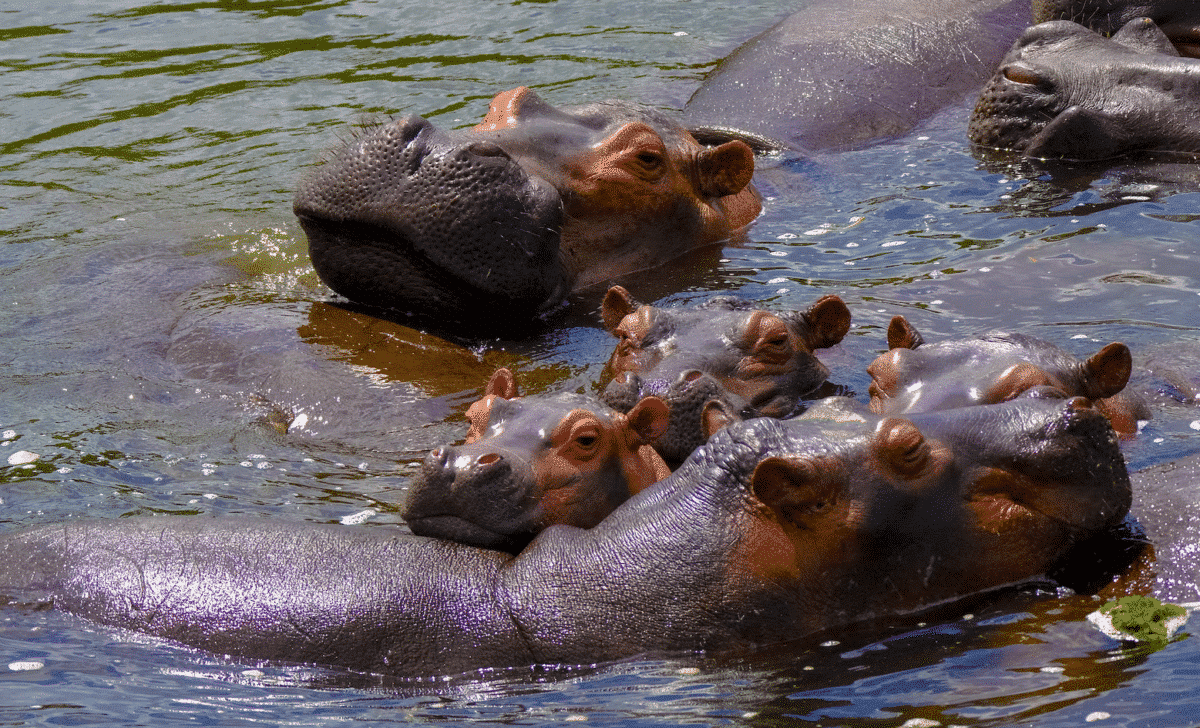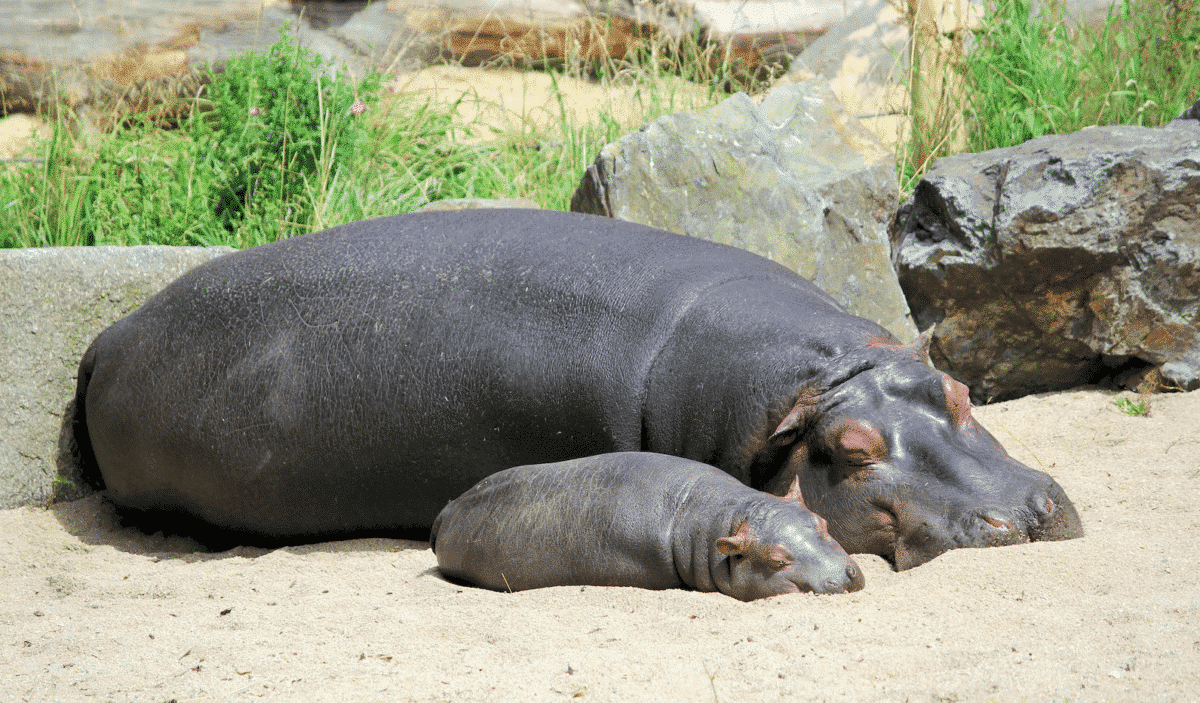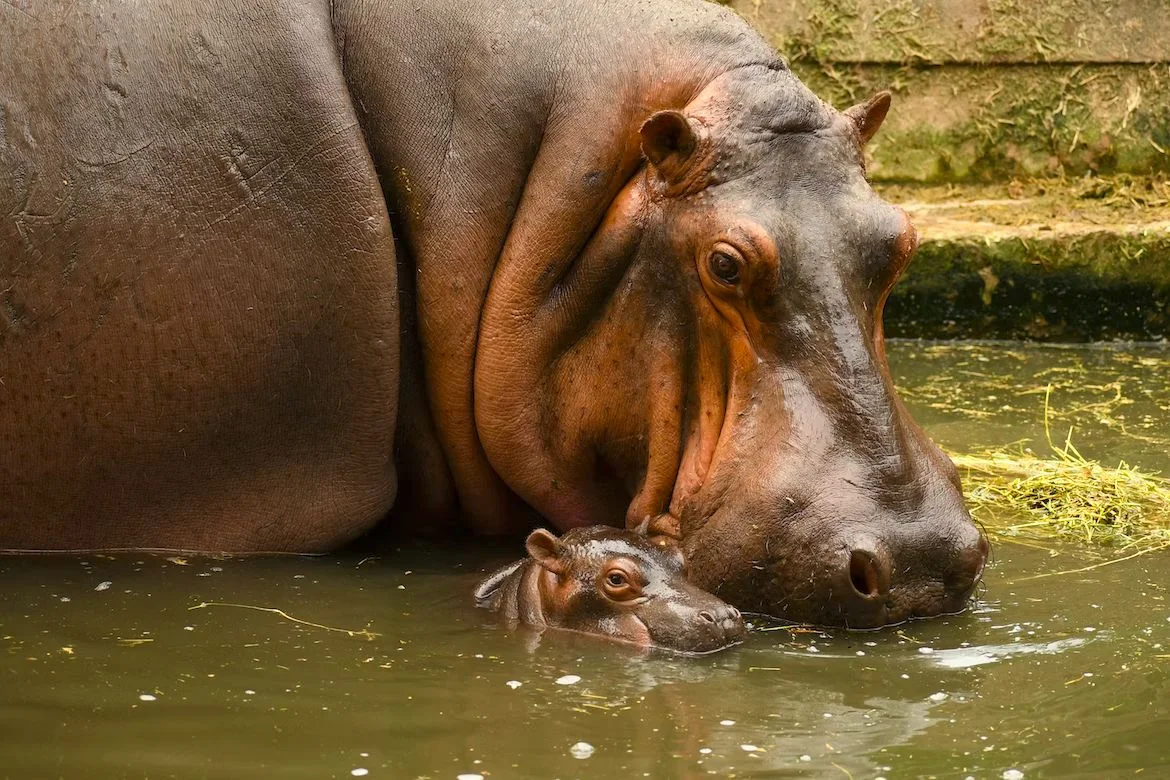Welcome to Big Personalities in Tiny Packages: Baby Hippos. Let’s swim straight in!
Did you know that a baby hippo can weigh up to 100 pounds at birth? That’s just the beginning of the awe-inspiring facts about these adorable creatures.
But did you also know that despite their cute and cuddly appearance, baby hippos are actually one of the most dangerous animals in the world?
In this article, we’ll explore the fascinating world of baby hippos, from their physical characteristics, behavior, habitat, and conservation status. Get mesmerized by these intriguing creatures and learn why they’re worth protecting.
Want to swim ahead? Click below
SETTING THE STAGE: Baby Hippos and Their Unique Characteristics

Hippos are some of the most fascinating creatures on the planet, and their babies are no exception. These adorable creatures are born weighing up to 100 pounds, with their eyes open and fully able to walk.
Unlike most other mammals, baby hippos can stay underwater for up to 30 seconds and can swim alongside their mothers just hours after birth.
So why are baby hippos worth discussing?
For starters, they’re an important part of the natural world, and learning about them helps us appreciate and understand the delicate balance of ecosystems.
But beyond that, baby hippos have an undeniable charm and fascination that captures the hearts of people of all ages. Whether you’re a nature enthusiast or simply love cute animals, there’s no denying the appeal of baby hippos.
As we tag along, we’ll delve into the unique characteristics of baby hippos; their physical appearance, their behaviors and habitats. You’ll discover just what makes these animals so special and why they deserve our attention and protection.
So let’s dive in and explore the world of baby hippos.
These Physical Characteristics of baby Hippos will surprise you
- Size and weight of baby hippos
When it comes to baby hippos, size definitely matters! These chunky little cuties are born weighing between 60-110 pounds, which is no small feat, if you ask us.
They’re also about 4 feet long, which makes them more than just a handful. But don’t get too attached to their small size, because these babies grow up fast!
Before you know it, they can weigh up to a ton and reach lengths of 15 feet or more! That’s right, they go from cute and cuddly to massive and mighty in just a few short years.
Talk about growing like a weed! To put their growth in perspective, a baby hippo will grow over ten times its weight within the first year of its life, which is faster than a baby elephant!
- Appearance and distinguishing features
When it comes to the appearance of baby hippos, they have a few tricks up their sleeves to make them stand out.
They have a reddish-brown or grey color that helps them blend in with their surroundings, especially when they’re covered in mud to keep cool. But their most distinguishable feature has to be their jaws.
These babies have massive, powerful jaws that are lined with large, sharp teeth. It’s a good thing they’re cute, because those chompers are no joke!
But don’t let their tough exterior fool you, these little ones have hearts of gold. And compared to other baby animals, their teeth are actually some of the first things to come in!
Development from birth to adulthood
The development of baby hippos is truly a sight to behold. They grow rapidly, which is why they’re always one step ahead of you. By the time they reach one year of age, they can weigh up to 600 pounds, which is enough to make your jaw drop.
As they mature, their skin becomes thicker, making them even more durable. And if that wasn’t enough, their teeth grow even larger, making them even more intimidating. But don’t worry, they’re still as cute as ever.
By the time they reach adulthood, they are massive and powerful creatures that can cause a lot of damage if they feel threatened. It’s important to remember that while they may be cute as babies, they’re not to be trifled with.
In comparison, adult hippos are one of the most dangerous animals in Africa, but as babies, they’re just big balls of fluff.
Behavior and Habitat

Baby hippos are known for their playful and curious personalities, but there’s much more to these creatures than meets the eye. Regarding their behavior and habitat, these little ones have some unique and fascinating traits.
Relationship Between Baby Hippos and Their Mothers
Baby hippos have a very strong bond with their mothers, and they fiercely protect them. The mother hippo is always nearby, keeping a watchful eye on her little one and making sure it stays safe and sound.
In fact, the mother hippo is so protective, she will fiercely defend her baby from any potential threat, even if that means taking on a much larger animal. It’s a true testament to the unbreakable bond between a mother and her baby.
It’s like the saying goes, “A mother’s love knows no bounds.”
Living Conditions and Habitat Preferences
When it comes to living conditions, baby hippos are quite adaptable. They can be found in a variety of habitats, from rivers and lakes to swamps and marshes.
However, they do have a few preferences when it comes to their living conditions. For example, they prefer to be in bodies of water that are deep enough to provide them with protection from predators but shallow enough for them to be able to touch the bottom with their feet.
It’s a delicate balance, but these little ones know what they want and aren’t afraid to ask for it!
Interaction with other animals in their environment
Contrary to popular misconception, baby hippos are not just loners and they love to socialize with others of their kind.
In fact, they’re often found in groups, where they play and interact with each other. But that’s not all; they also have a knack for forming unlikely friendships with animals outside of their species.
For example, they are closely related to birds, which often perch on their backs and use them as a floating raft.
This may seem strange, but these birds are taking advantage of the hippo’s large size and protective nature to stay safe from predators. In turn, the hippos benefit from the birds picking off any parasites from their tough skin.
This friendly relationship between animals from different species is a testament to the hippo’s sociable nature and their ability to find common ground with others. They truly are social creatures, and it’s always a beautiful sight to see them interacting with each other in their natural habitats.
Not only does this showcase the remarkable behavior and social skills of baby hippos, it also highlights the fascinating dynamics of animal interactions in the wild. It’s a sight to behold and makes baby hippos even more endearing and intriguing.
Diet and Feeding Habits: Delving Deeper into the Gastronomic World of Baby Hippos
With their adorable demeanor and chubby bodies, baby hippos have surprisingly complex diets and feeding habits. Let’s delve deeper into the gastronomic world of these little wonders.
Nutritional Requirements of Baby Hippos: Fueling their Growth and Development
Baby hippos require a balanced diet to support their growth and development, and their dietary needs are quite specific. As herbivores, they feed on a variety of vegetation, such as grasses, aquatic plants, and fruits, but they also need roughage to maintain their digestive health.
Their diet must be rich in calcium, as their skeletons grow quickly and need adequate amounts of this mineral to remain strong and healthy.
They also need plenty of protein to support their muscle growth and help them build a sturdy body. In short, baby hippos have a hearty appetite and need to consume a well-balanced diet to thrive.
Feeding Habits and Frequency of Meals: Eating like a King, or Rather, a Hippo
Baby hippos have high energy requirements and a fast metabolism, and they feed frequently to meet their needs. In their first year of life, they can consume up to 50 pounds of food in a single day. That’s a lot of grub! As they grow older, their energy needs decrease and so does their feeding frequency.
They tend to feed at night, as this is when they are most active and when the vegetation they feed on is at its most nutritious. During the day, they rest and digest their food, conserving their energy for their next feeding frenzy.
Types of Food Consumed by Baby Hippos: A Vegetarian’s Delight
Baby hippos feed on a variety of vegetation, including grasses, aquatic plants, fruits, bark, leaves, and twigs.
They have a unique digestive system that allows them to extract the maximum amount of nutrients from the food they eat, and their gut is home to a variety of bacteria that help break down tough plant material and extract the essential nutrients that the baby hippo needs to thrive.
In conclusion, the diet and feeding habits of baby hippos are a fascinating aspect of their lives, and a testament to their adaptability and resilience.
From their specific dietary requirements to their unique digestive system, baby hippos continue to captivate and amaze with their impressive habits and behaviors.
So next time you come across one of these little wonders, take a moment to appreciate the intricacies of their gastronomic world.
Efforts To Protect and Conserve Baby Hippo Populations

Conservation efforts for baby hippos are a top priority for many organizations and governments around the world. From creating protected areas for them to live in, to monitoring their populations and enforcing hunting laws, there are many ways that the survival of these magnificent creatures is being ensured.
Did you know that the Hippopotamus is considered one of the most dangerous animals in the world? Despite their seemingly friendly demeanor, they are known to attack boats and humans who venture too close to their territory.
This is why it’s important to have well-trained and equipped conservation teams working to protect baby hippos and their habitats. By providing them with the resources they need to thrive, we can ensure their survival for generations to come.
What are the Threats to Baby Hippos in the Wild?
As we delve deeper into the world of baby hippos, it’s important to address the challenges they face in the wild. Unfortunately, these adorable creatures are facing numerous threats that are putting their survival at risk.
Here are just a few of the many challenges baby hippos are up against:
- Habitat destruction
Baby hippos and their parents rely on the same habitats for food, water, and shelter. So, when their natural habitats are destroyed for human development or agriculture, both generations are left vulnerable and at risk of survival.
- Spawning ground destruction and degradation
Baby hippos are born in and around their mother’s spawning grounds. However, these spawning grounds are becoming increasingly scarce as they are being destroyed and degraded by human activities such as logging, agriculture, and dam building.
This not only puts the baby hippos at risk but also their future generations.
- Illegal hunting
Baby hippos are hunted for their meat, ivory teeth, and skin. This illegal trade is putting their survival in jeopardy and it’s imperative that stricter laws are enforced to protect these creatures from harm.
It’s truly heart-wrenching to see such magnificent creatures facing such threats. However, there is hope. Conservation efforts are underway to protect and conserve baby hippo populations and their habitats.
By educating the public about the importance of conservation, we can work together to ensure that baby hippos continue to thrive in the wild for generations to come.
Did You Know? Fascinating Facts About Baby Hippos

Baby hippos are fascinating creatures, and there is much to learn about these magnificent animals beyond their physical appearance and behavior.
Here are some fun and interesting facts and trivia about baby hippos that you may not know:
- Baby hippos are born underwater
When a baby hippo is born, it does so underwater. The mother will push the calf up to the surface to take its first breath. The newborn calf can hold its breath for up to 40 seconds and will naturally start to swim soon after birth.
- Hippos secrete a natural sunscreen
Hippos have a unique skin secretion that acts as a natural sunscreen, protecting them from the sun’s harmful rays. The secretion has also been found to have antibiotic properties, helping to keep the hippo’s skin healthy.
- Hippos are nocturnal creatures
Although they can be seen out and about during the day, hippos are most active at night. They are well adapted to living in the water and spend much of their time submerged, emerging only to breathe and to bask in the sun.
- Hippos are one of the closest relatives of whales
It may come as a surprise, but hippos are one of the closest living relatives of whales. Scientists believe that hippos and whales share a common ancestor that lived about 50 million years ago. This is evident in their similar skeletal structures and aquatic adaptations.
- Baby hippos are incredibly agile
Despite their large size and weight, baby hippos are surprisingly agile and can move quickly on land and in water. They are strong swimmers and can hold their breath for several minutes, allowing them to dive to the bottom of rivers and lakes.
- Hippos are voracious eaters
Hippos are herbivores and consume vast quantities of vegetation every day. An adult hippo can eat up to 100 pounds of vegetation in a single day. They are especially fond of grass and can graze for hours at a time.
- Baby hippos are excellent divers
They are born with a natural ability to dive and swim. Furthermore, they can hold their breath for up to 40 seconds and can dive to depths of around 10 feet. This allows them to avoid predators and access underwater vegetation.
- Hippos communicate through grunts and roars
Despite their seemingly docile appearance, hippos are quite vocal. Baby hippos communicate with their mothers through a series of grunts and snorts, and they can recognize their mother’s unique calls from other hippos.
- Hippos are incredibly territorial
Hippos are fiercely territorial creatures and will defend their territory aggressively. This is especially true during mating season when males will engage in violent battles over access to females.
- Baby hippos are born with full sets of teeth
When they are born, they have a complete set of teeth ready to start munching on vegetation almost immediately. This allows them to keep up with their mother’s voracious appetite and grow quickly.
Fun Trivia

- What is a group of hippos called?
A group of hippos is a bloat or a pod.
- How long do baby hippos stay with their mothers?
They stay with their mothers for up to 8 years, during which time they learn how to survive in the wild.
- Are hippos related to pigs?
No, hippos are not related to pigs but are more closely related to whales and dolphins.
- What is the lifespan of a baby hippo in the wild?
Their lifespan in the wild is around 40 years, but they can live up to 50 years in captivity.
- How do baby hippos protect themselves from predators?
Their mothers protect them and are known to be extremely aggressive and will fiercely defend their young from any perceived threat.
Wrapping Up with Baby Hippos
Baby hippos are truly remarkable creatures that deserve our attention and protection. As we’ve learned throughout this article, they’re adorable and cuddly and play a crucial role in maintaining healthy ecosystems.
From their impressive size and weight at birth to their unique swimming abilities and close bond with their mothers, baby hippos are full of surprises.
So let’s do our part to keep these fantastic animals safe and thriving. As the old saying goes, “It takes a village,” and when it comes to conservation, that couldn’t be more true.
By supporting organizations that work to protect hippos and their habitats and spreading awareness about the importance of conservation, we can ensure that baby hippos continue to enchant and amaze them for generations to come.
And with that, we come to the end of our journey into the world of baby hippos.
Thanks for following along with us! Next up Best Places to See Hippos.
- Watch Hippo Mother Chases Crocodiles To Protect Her Dead Child - April 15, 2024
- Watch Elephants Ask Rescuer To Play Piano - April 12, 2024
- Top Techniques To Cleaning Up Dog Vomit - April 11, 2024


